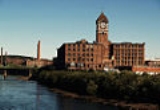
American Woolen Company
Overview
William Madison Wood
William M. Wood was a textile mill owner of Lawrence, Massachusetts who was considered to be an expert in efficiency. He made a good deal of his fortune through being hired by mill owners to turn around failing mills and was disliked by organized labor.- Early life :William Wood was born in 1858...
and his father-in-law Frederick Ayer
Frederick Ayer
Frederick Ayer was an American businessman and the younger brother of patent medicine tycoon Dr. James Cook Ayer. He graduated from The Hill School. In addition to his involvement in the patent medicine business, he is better known for his work in the textile industry...
through the consolidation of eight financially troubled New England
New England
New England is a region in the northeastern corner of the United States consisting of the six states of Maine, New Hampshire, Vermont, Massachusetts, Rhode Island, and Connecticut...
wool
Wool
Wool is the textile fiber obtained from sheep and certain other animals, including cashmere from goats, mohair from goats, qiviut from muskoxen, vicuña, alpaca, camel from animals in the camel family, and angora from rabbits....
en mills. At the company's height in the 1920s, it owned and operated 60 woolen mills across New England. It is most known for its role in the Lawrence textile strike
Lawrence textile strike
The Lawrence Textile Strike was a strike of immigrant workers in Lawrence, Massachusetts in 1912 led by the Industrial Workers of the World. Prompted by one mill owner's decision to lower wages when a new law shortening the workweek went into effect in January, the strike spread rapidly through the...
of 1912.
The American Woolen Company was the product of the era of trusts
Trust (19th century)
A special trust or business trust is a business entity formed with intent to monopolize business, to restrain trade, or to fix prices. Trusts gained economic power in the U.S. in the late 19th and early 20th centuries. Some, but not all, were organized as trusts in the legal sense...
.

